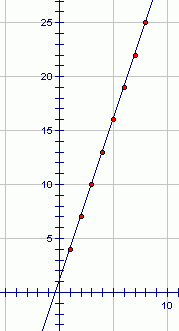
are the terms of the sequence. If the domain of the function consists of the first n positive integers only, the sequence is a finite sequence.
Some sequences are defined recursively. To define a sequence recursively, you need to be given one or more of the first few terms. The Fibonacci sequence is a good example
Ex.
 , where
, where 
The first six terms of this sequence are
Factorial: If n is a positive integer, n factorial is defined by
****As a special case, zero factorial is defined as  ****
****
Evaluating Factorial Expressions
Ex.

Summation Notation: The sum of the first n terms of a sequence is represented by
where i is called the index of summation, n is the upper limit of summation, and 1 is the lower limit of summation.
Ex. =(1+3^{2})+(1+4^{2})+(1+5^{2})+(1+6^{2}))
Properties of Sums
1.  , c is any constant
, c is any constant
2. =\sum_{i=1}^{n}a_{i}+\sum_{i=1}^{n}b_{i})
3. =\sum_{i=1}^{n}a_{i}-\sum_{i=1}^{n}b_{i})
Arithmetic Sequence: A sequence is arithmetic if the differences between consecutive terms are the same. So, the sequence
is arithmetic if there is a number d such that
The number d is the common difference of the arithmetic sequence.
*The nth term of an arithmetic sequence has the form
where d is the common difference between consecutive terms of the sequence and 

The Sum of a Finite Arithmetic Sequence
The sum of a finite arithmetic sequence with n terms is
Finding a Partial Sum of an Arithmetic Sequence
Find the 150th partial sum of the sequence
5, 16, 27, 38, 49....
Solution
For this arithmetic sequence, you have  and
and  So,
So,
and the nth term is
Therefore, -6=1,644,) and the sum of the first 150 terms is
and the sum of the first 150 terms is
Geometric Sequence: A sequence is geometric if the ratios of consecutive terms are the same.
The number r is the common ratio of the sequence
*The nth term of a geometric sequence has the form
where r is the common ratio of consecutive terms of the sequence. So, every geometric sequence can be written in the following form
*The sum of the geometric sequence
with common ratio  is
is
The Sum of an Infinite Geometric Series
If  then the infinite geometric series
then the infinite geometric series
has the sum





No comments:
Post a Comment